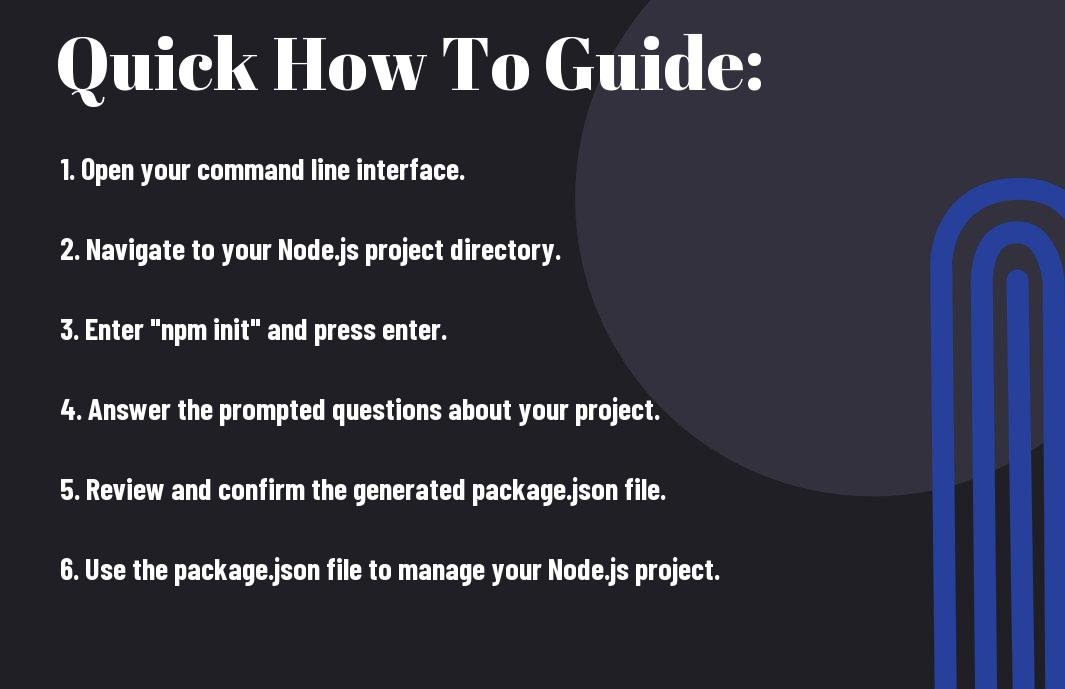Have you ever wondered how to properly manage your Node.js projects? Well, Package.json is the key to effective project management. In this guide, I will show you exactly how to get started by obtaining the Package.json file. This file is crucial as it not only keeps track of your project’s dependencies, but also allows you to define scripts, manage versions, and set up important details for your project. By the end of this tutorial, you will have a clear understanding of this essential file and be ready to kick off your Node.js project with confidence. So, let’s dive in and get you on the right track to successful Node.js project management.
Key Takeaways:
- Package.json File: The package.json file is a crucial part of every Node.js project, as it contains important metadata and dependencies for the project.
- Initialization: To create a package.json file, you can simply run the npm init command in your project directory and follow the prompts to set up the file.
- Dependency Management: The package.json file allows you to easily manage and install project dependencies using the npm install command.
- Version Control: By including a package.json file in your project, you can ensure that your dependencies are consistent and easily shareable with others using version control systems like Git.
- Scripting: The package.json file also enables you to define custom scripts for various tasks, making it easier to run common commands for your project.
Understanding the Package.json File
The Package.json file is a crucial component of any Node.js project. It serves as a manifesto for the project, containing important information about the project itself and its dependencies. Understanding the contents and significance of this file is key to effectively managing your Node.js projects.
What is the Package.json File
The Package.json file is a metadata file that contains information about the Node.js project. It includes details such as the project’s name, version, description, and dependencies on external packages. This file is essential for managing the project’s dependencies and scripts, and it plays a vital role in ensuring the project’s integrity and usability.
Why is the Package.json File Important for Node.js Projects
The Package.json file is crucial for Node.js projects as it acts as a blueprint for the project’s structure and dependencies. It allows you to define the project’s dependencies, specify scripts for automation, and set project configurations. Moreover, it enables you to easily share your project with others, ensuring that they can quickly understand and set up the project with all its necessary dependencies.
How-To Get the Package.json File
Obviously, the first step in managing a Node.js project is to obtain the package.json file. This file is crucial for managing dependencies, scripts, and project metadata. Without this file, your project will be difficult to manage and share with others. Let’s discuss a few methods to obtain the package.json file for your Node.js project.
Method 1: Creating a Package.json File from Scratch
If you are starting a new Node.js project from scratch, creating a package.json file manually is the first step. You can do this by creating a new directory for your project and running the command npm init. This will prompt you to enter details about your project, such as the name, version, description, entry point, and more. Once you have provided all the necessary details, npm will generate the package.json file for you.
Method 2: Using npm init Command to Generate Package.json File
Another way to get the package.json file is by using the npm init command. This command allows you to generate a package.json file for an existing project that may not have one. By running npm init in the project directory, npm will guide you through a series of questions to gather project details, and then create the package.json file based on your responses.
Method 3: Cloning an Existing Node.js Project with Package.json File
If you are working on a project that already has a package.json file, you can easily obtain it by cloning the project repository from a version control system such as Git. By cloning the project, you will not only get the package.json file, but also the entire project structure, including code, configuration files, and other assets.
Tips for Managing the Package.json File
Unlike package-lock.json, which is automatically generated and should not be edited directly, package.json is the file you will frequently interact with when managing your Node.js project. Here are some tips for effectively managing your package.json file:
- Use npm init to create a new package.json file for your project, or npm init -y for a quick default setup.
- Keep the dependencies and devDependencies sections organized and updated to ensure smooth functioning of your project.
- Regularly review and update the scripts section to automate common tasks and streamline your workflow.
Assume that managing your package.json file is an ongoing process, and staying organized will save you time and effort in the long run.
Best Practices for Updating Package.json File
When updating your package.json file, it’s crucial to follow best practices to avoid potential issues. I recommend keeping a record of changes, using precise versioning, and validating dependencies to ensure compatibility with your project.
Understanding and Managing Dependencies in Package.json
Understanding and managing dependencies in your package.json file is essential for the stability and security of your Node.js project. I always prioritize updating dependencies regularly, reviewing security warnings, and utilizing npm audit to identify potential vulnerabilities in installed packages.
Factors to Consider When Working with Package.json
Now, when working with Package.json, there are several factors to consider in order to effectively manage your Node.js project. First and foremost, it is crucial to understand the dependencies listed in your Package.json file. This includes both direct dependencies and transitive dependencies that are indirectly required by your project. Keeping track of these dependencies is essential for ensuring the stability and security of your project. Additionally, it is important to consider the versioning strategy for each dependency, as well as the compatibility with other packages in your project. Properly managing these factors will help avoid potential issues and conflicts down the line.
- Understanding dependencies and their types
- Versioning strategy and compatibility
- Managing potential conflicts
Any oversight in managing these factors can result in unwanted bugs, security vulnerabilities, and project instability.
Compatibility and Versioning Issues
When it comes to Package.json, compatibility and versioning issues can be a common challenge. It is essential to carefully evaluate the compatibility of dependencies with one another. Mismatched versions can lead to conflicts, breaking changes, and overall instability in your project. Similarly, improper version constraints or updating without thorough testing can also result in compatibility issues. It is crucial to maintain a clear understanding of these factors to ensure a smooth and stable development process.
Understanding the npm Registry and Package.json
Working with Package.json goes hand in hand with understanding the npm registry. The npm registry serves as a central repository for Node.js packages, and it is where Package.json gets its dependencies from. By leveraging the npm registry effectively, you can discover, install, and manage packages for your project seamlessly. It is important to regularly update and maintain your Package.json file to reflect the most recent, stable, and secure versions of your dependencies available on the npm registry.

Conclusion
With these considerations in mind, obtaining a package.json file is your first step towards efficient project management in Node.js. By creating and customizing this file, you can easily manage and track your project’s dependencies, scripts, and metadata. It not only ensures smoother deployment and distribution of your project, but also allows for seamless collaboration with other developers. So, take the time to carefully craft your package.json file and reap the benefits of streamlined project management in Node.js.
FAQ
Q: What is a package.json file?
A: A package.json file is a metadata file in a Node.js project that contains important information about the project, including its dependencies, scripts, and version. It is used for managing the project’s dependencies and scripts.
Q: How do I create a package.json file?
A: To create a package.json file, you can navigate to the root directory of your Node.js project using the command line and run the command ‘npm init’. This command will guide you through a series of prompts to set up the necessary information for your package.json file.
Q: What is the purpose of a package.json file?
A: The package.json file is essential for Node.js project management. It allows developers to specify project information such as name, version, description, and dependencies. It also enables the execution of project-specific scripts and simplifies the process of sharing and reproducing the project.
Q: How do I add dependencies to my package.json file?
A: You can add dependencies to your package.json file by running the command ‘npm install
Q: Can I manually edit the package.json file?
A: Yes, you can manually edit the package.json file to update project information, add or remove dependencies, and modify scripts. However, it is recommended to use npm commands for managing dependencies and scripts to maintain consistency and avoid errors.












